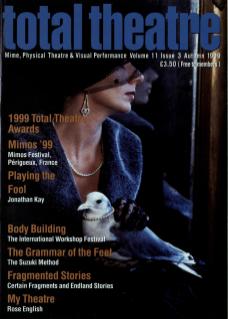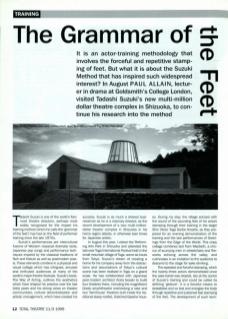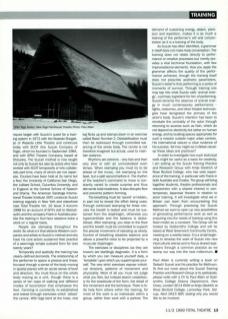Tadashi Suzuki is one of the world's foremost theatre directors, perhaps most widely recognised for the impact his training method (which he calls the 'grammar of the feet') has had on the field of performer training since the late 1970s.
Suzuki's performances are intercultural fusions of Western classical dramatic texts, Japanese pop songs and performance techniques inspired by the classical traditions of Noh and Kabuki as well as postmodern praxis. These elements combine in a physical and visual collage which has intrigued, amused and enthused audiences at many of the world's major theatre festivals. Suzuki's book, The Way of Acting, outlines the aesthetics which have shaped his practice over the last thirty years and his strong views on theatre communities, cultural decentralisation and artistic management, which have created his success. Suzuki is as much a shrewd businessman as he is a visionary director, as the recent development of a new multi-million dollar theatre complex in Shizuoka in his home region attests, in otherwise lean times for Japanese artists.
In August this year, I visited the Performing Arts Park in Shizuoka and attended the last ever Toga International Festival held in the small mountain village of Toga, some six hours from Tokyo. Suzuki's dream of creating a home for his company away from the distractions and assumptions of Tokyo's cultural scene has been realised in Toga on a grand scale. He has collaborated with Japanese post-modem architect Arata Isozaki to build four theatres there, including the magnificent Greek amphitheatre overlooking a lake and two ‘farmhouse' theatres built inside the traditional steep-rooted, thatched Gassho houses. During my stay, the village echoed with the sound of the pounding feet of his actors stomping through their training in the larger Shin (New) Toga Sanbo theatre, as they prepared for an evening demonstration of the training and the last performances of Greetings from the Edge of the World. This crazy collage combines text from Macbeth, a chorus of scurrying men in wheelchairs and fireworks echoing across the valley, and culminates in an invitation to the audience to descend to the stage for sake drinking.
The repeated and forceful stamping, which the twenty-three actors demonstrated once the sake barrel was cleared, lies at the centre of Suzuki's training and could be called its defining 'gesture’. It is a forceful means to destabilise and so test and energise the body through repetitive and sustained fast stamping of the feet. The development of such techniques began with Suzuki's quest for a training system in 1972 with the Waseda Shogekijo or Waseda Little Theatre and continues today with SCOT (the Suzuki Company of Toga), which he founded in September 1984, and with SPAC Theatre Company, based at Shizuoka. The Suzuki method is now taught not only by Suzuki but also by actors who have worked with SCOT temporarily or who collaborate part-time, many of whom are not Japanese. Courses have been held at (to name but a few) the University of California San Diego, the Juilliard School, Columbia University, and in England at the Central School of Speech and Drama. The American Saratoga International Theater Institute (SITI) conducts Suzuki training regularly in New York and elsewhere (see Total Theatre Vol. 10 Issue 3 Autumn 1998 for an account of SITI's visit to Aberystwyth) and the company Frank in Australia practise the training in four-hour sessions twice a week on a regular basis.
People are stamping throughout the world. So what is it that attracts Western companies and artists to Suzuki's method and why have his core actors sustained their practice of a seemingly simple outward form for over twenty years?
Temporally and spatially the training has clearly defined demands. The relationship of the performer to space is precise and linear, focused through a sense of the body moving in spatial planes with an acute sense of level and direction. You must focus on the whole body moving as a unit, though there is a series of ten ways of walking and different modes of locomotion that emphasise the feet. Centring is constantly re-established and tested through exercises which 'attack’ the centre. With legs bent at the knee, one leg flicks up and stamps down in an exercise called Basic Number 2. Destabilisation must then be redressed through controlled balancing of the whole body. The centre is not therefore imagined but actual, used to maintain balance.
Rhythms are extreme – very fast and then very slow or with an unmodulated even tempo. When stamping you must try to be ahead of the music, not stamping on the beat, but a split second before it. The rhythm of the teacher's command to move is constantly varied to create surprise and thus demands total readiness. It also disrupts flow and prevents pattern-forming.
The breathing must be 'secret' or hidden, in part not to reveal the effort being used. Through continued stamping for three minutes the breath is tested and must be sustained from the diaphragm, otherwise you hyperventilate and the balance is destabilised. After stamping, you relax to the floor and the breath must be controlled to support the precise movement of standing up slowly. Control of breathing steadies balance and allows a powerful voice to be projected by a muscular diaphragm.
The exercises or disciplines (as they are known) are startlingly diagnostic. It is a form by which you can measure yourself daily, a ‘template' upon which you superimpose your self. The very strict exercises expose individual tensions, patterns of movement and physicality. Most of all you must not judge what you feel, but instead search ceaselessly for the exactitude of the form, the detail of the movement and the technique. There is little help from others within the training, for most of the work is as individuals within a group, rather than work with a partner. The demand of sustaining energy, attack, precision and repetition, makes it is as much a training of the performer's will and concentration as it is a training of the body.
As Suzuki has often identified, a grammar in itself does not make lively conversation. The training does not relate directly to performance or creative processes but merely provides a vital technical foundation, with few improvisational elements. How you apply the grammar affects the quality of the performance achieved, though the training itself does not prescribe aesthetic parameters. Suzuki's belief is that performing is a series of moments of survival. Through training one may tap into what Suzuki calls animal energy, a primary ingredient for him of performing. Suzuki laments the absence of animal energy in much contemporary performance – lights, costumes, and other theatre technologies have denigrated the primacy of the actor's body. Suzuki's intention has been to reinstate the centrality of the actor through returning to sources such as Noh, which do not depend on electricity but rather on human energy, and by building spaces appropriate for such a mission outside major urban centres. His international stature is clear evidence of his success. Yet how might we in Britain develop these ideas and practices?
In order to investigate how such technical work might be useful as a basis for creativity, I am setting up the Suzuki Training Practice and Research Group with Antje Diedrich of Rose Bruford College, who has wide experience of the training, in particular with Frank in both Australia and Croatia. The group will bring together students, theatre professionals and researchers with a shared interest in contemporary Japanese theatre in relation to actor training. It will investigate what we in Britain can learn from encountering this approach. Through practising the Suzuki Method we want to open up new possibilities of generating performance work as well as enquiring into the needs of training using this fixed model as a constant. The Group will be hosted by Goldsmiths College and will be based at West Greenwich Community Centre, meeting on a weekly basis. It is a small beginning to develop the work of Suzuki into new intercultural arenas and to focus shared aspirations through a common practice as we stomp our way into the next millennium.
Paul Allain is currently writing a book on Tadashi Suzuki and his practice for Methuen. To find out more about the Suzuki Training Practice and Research Group or to participate, please write with a CV to Paul Allain at Goldsmiths College Drama Department, New Cross, London SE14 6NW or Antje Diedrich at Rose Bruford College, Lamorbey Park, Sidcup, Kent DA15 9DF, stating why you would like to be involved.


